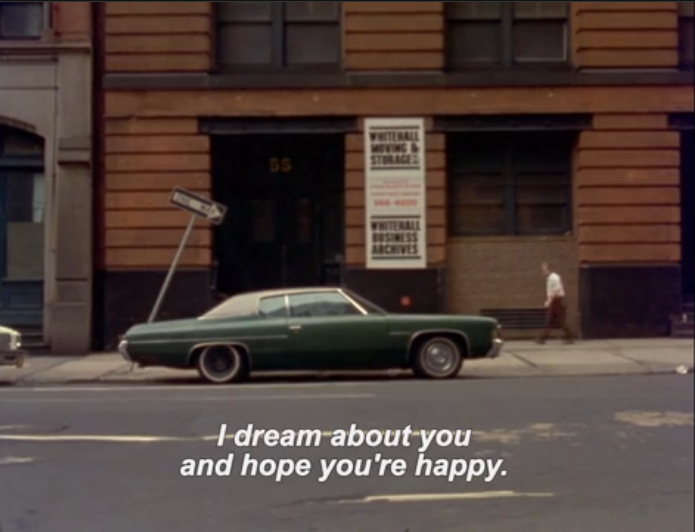the creator’s presence in akerman’s cinema
To watch Chantal Akerman’s meditative urban study News From Home (1977) is to witness a uniquely personal experimentation of cinema. Akerman deftly subverts common narrative in favor of a combination of sound and visuals that evokes longing, banality, isolation, struggle, movement. She is able to create something profoundly personal without characters or plot, bringing us into a place and a relationship that is grounded in lived experience while feeling like an abstract stream of conscious.
Structurally the film offers an hour and a half of prosaic, mostly street-level footage that is obliquely contextualized by an epistolary voice-over connecting mother and daughter. Time is movement – some scenes are slow, some are fast, some are static, depending on how the camera moves through space, just as our own movements through the city have varying times and speeds depending on our transport. The camera organically inhabits this space, creating a documentarian reflection of New York that somewhat recalls the “city symphonies” of the 20s and 30s.

But this is more than a record of urban life and architecture; Akerman’s New York is omnipresent and interwoven with her displaced identity. The absence of her physical form on the screen has the effect of enmeshing her experience into the fabric of the city itself – anonymous but part of a larger whole. Her voice channels a mother’s worry as she navigates its “murky canyons” (Barker), disembodied and anonymous yet entrenched in the grit of daily life. The soundtrack is plotless and seemingly disconnected from the images that pass on screen, yet these images are “grounded in the human body and its resonance with the body of the city,” (Barker) as Akerman’s camera flows namelessly through these spaces. The camera settles for long moments on people living through their lives – anonymous too, but captured with hyper-realist attention, as if to remind us of the many untold stories swirling around us.
Akerman is “present” as the voice and presumably as the POV, but she avoids letting herself be the object. Despite being a deeply personal film, the mother in those letters could be any of our mothers, and the sense of busy isolation as the camera moves through urban space feels familiar. The combination of her physical disembodiment and the shifting focus of different bodies throughout the city creates a ground-level perspective that’s easily inhabited by the audience. There is also a class consciousness in how the camera moves among the typically unseen, lived-in struggles of daily urban life. There is absolutely nothing forced or artificial here, just the real-world bodies of people going to or from work, caring for children, etc. This is not the glamorous New York of On the Town, or even the heightened world of intrigue of Rear Window or Naked City. It’s a blunt and unadorned shared reality.

We are not given much detail of either the mother or the daughter; only what we can discern through letters recited between them. In a way this lack of information puts us right in the mother’s shoes, who constantly requests more communication and details about her daughter’s life in this big city and its perceived perils. It’s unclear to us whether the daughter is thriving or flailing in her life. The scenes evoke a lonely anonymity and perhaps a homesickness, particularly the last, silent shot of the receding skyline taken from the Staten Island ferry. Throughout the film, this interplay of city scenes and Akerman’s voice (or lack of) creates a resonance and sympathy with both “characters,” one far away in an idyllic and familial home, the other adrift in an urban sea.
Works Cited:
Barker, Jennifer M. (2003). The feminine side of New York: travelogue, autobiography and architecture in ‘News from home’. Gwendolyn Audrey (ed.), Identity and memory: the Films of Chantal Akerman (pp. 41-58). Illinois: Southern Illinois University Press.
News From Home. Dir. Chantal Akerman. Criterion, 2010. Film.
